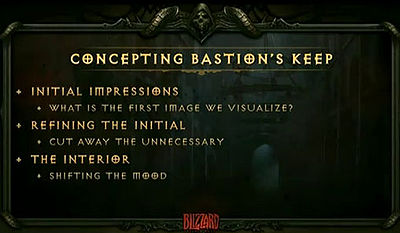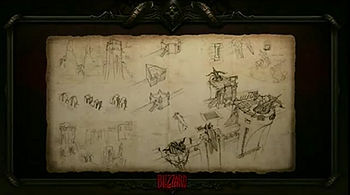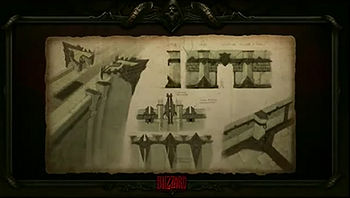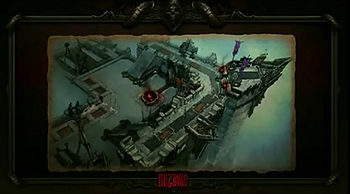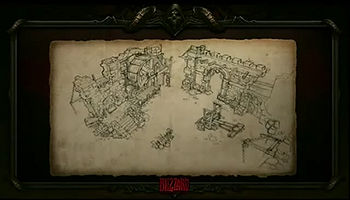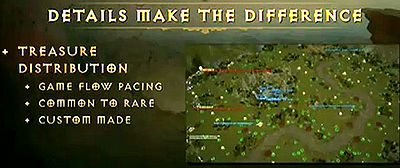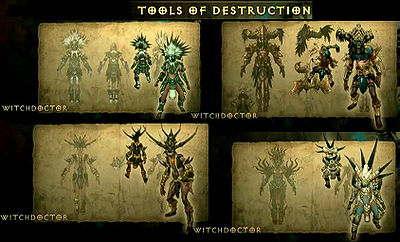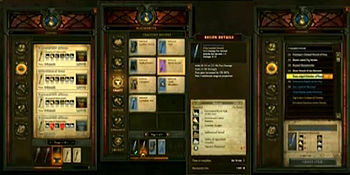Difference between revisions of "Crafting Sanctuary Panel Blizzcon 2010"
(Created page with 'The Crafting Sanctuary Panel was held at Blizzcon 2010, on Saturday afternoon. This was the second Diablo III panel at Blizzcon 2010, and covered various game design details incl…') |
(No difference)
|
Revision as of 09:52, 29 November 2010
The Crafting Sanctuary Panel was held at Blizzcon 2010, on Saturday afternoon. This was the second Diablo III panel at Blizzcon 2010, and covered various game design details including level design, artisans and crafting, items and gear sets, and more.
This panel is a must watch for Diablo fans interested in the creative process behind the game's development.
Contents
Panel Description
The official description from the Blizzcon program:
- Diablo III: Crafting Sanctuary
- Saturday 10:30am, Developer Panel Stage
- The designers, artists, programmers, and writers share new information on the characters, creatures, game systems, and story of Diablo III.
Panel Participants
- Jay Wilson -- Game Director
Kevin Martens -- Lead content designer Josh Tallman -- senior concept artists
- Pete Cooper -- senior environment artist. "the tree guy"
- Jason Bender -- senior system designer
- Jill Harrington -- senior technical artist
- Steve Schmezulik -- gameplay programmer
- Christian Lichtner -- technical director, Unicorn Caretaker.
- Michael Nicholson -- senior user interface artist
View the Panel
The panel ran nearly an hour, and can be seen in four videos, courtesy of Diablo3Inc's extensive Diablo You Tube channel.
|
Part One covers "action story telling," as well as "opt in" story. Examples of this are then shown in a lengthy discussion of Bastion's Keep. |
Part Two continues the Bastion's Keep discussion, then moves into treasure object placement, variety in dungeons, and then monster design and AI. |
|
Part Three finishes the monster AI discussion, then moves on to Armor Sets. Item drops and randomization, and then coverage of the Artisans and Crafting. |
Part Four continues the Artisan interface discussion, moves into the Artisan wagon design, and Artisan level ups. |
Action Story Telling
Kevin Martens discusses their methods of "action story telling." Blizzard's motto is "play don't tell." This wasn't done that well in Diablo II, with many long NPC speeches that players had to sit and listen to, rather than learning the story while playing. Diablo III lets you listen to NPC speeches while playing, and shares more of the story through the gameplay itself.
An example is shown, from a mini-quest in Act One, in which the player finds an NPC weapon maker who requests assistance.
- "I will make an example of Dargon, that traitorous cur. Help me hunt him, and I will sell to you, instead of those Zealots."
That's his entire speech, given quickly, and finished while running along beside the player, who is already in the process of carrying out the quest actions. The quest, as seen in the PvM demo at Blizzcon 2010, was very short, and after just a few minutes the player successfully caught up to Dargon. At that point he runs towards a Cultist leader and begs for assistance.
- Dargon: "Master, help me. The crazed weapon-maker wants my head!"
- Cultist boss': "What makes you think I care for your life? Kill them, my pets."
(The cultist boss was not named and didn't fight back in the demo, but you can be sure he'll be more of a challenge in the final game.)
After the battle with the cultist leader and his three Champion Berserkers, the player will naturally spend a moment looking over the items the monsters dropped. The NPC fills that time by giving a short speech that wraps up the quest:
- "Now that Dargon is dead, no one shall question my reputation or my resolve. Now for my goods. You'll find none better!"
As soon as he speaks, an NPC merchant interface opens up, giving the player an opportunity to buy and sell weapons and items.
Lore Books
Lore books are described by Kevin Martens:
An example is shown, with King Leoric heard reading from hid diary while the player continues battling monsters:
- "I am convinced that some malevolent being is attempting to wrest control of my thoughts away from me. I hear voices urging me to horrendous acts. There are times when I seem unable to control myself. Lazarus knows, I'm certain of this.
Bastion's Keep
The developers also try to make the player's experience more interesting by putting the characters into important actions. The example given is Bastion's Keep, in which the player joins in the defense of an ancient Barbarian fortress. The player isn't just killing enemies, you are participating in a grand scale event, and moving all throughout the huge fortress battling demons at the direction of various NPCs and in the process of advancing the story.
There are many locations within Sanctuary which are rich in history, culture, character, and lore. It is not often that we get to hear from the creators of such places about how they are built from concept to in-game representation. Fortunately, in the case of Bastion's Keep, that is exactly what we got at BlizzCon 2010. A fair portion of the Crafting Sanctuary panel at that year's BlizzCon was dedicated to Bastion's Keep, from intent to the finalized area that we will all, one day, finally be able to play.
The following sub-sections are taken from the crafting panel at BlizzCon 2010, narrated by various members of the development team.
Conceptualizing the Keep
(Narrated by Josh Tallman.)
When we were told that there was going to be a siege portion of the game, one of the first images that popped into our heads was the image of a battleship. Now, on a battleship there are a lot of shapes that really reinforce the idea that it's supposed to be this impenetrable fortress. So, we decided to work those ideas into our early sketches, and see how they turned out.
If you look at those, for example, maybe you see that giant iron spike-like thing hanging off of a chain that kind of reminds you of an anchor. The walkways of the fortress are already kind of long, and elongated, and they kind of resemble a ship anyway. So instead of having archers, maybe we should have giant ballistas on rotating platforms. Kind of reminds you of guns on a gunship, and maybe instead of round towers or the typical square towers, we could try to have the towers be triangles to remind you of the bow of a battleship.
That triangular shape is something that all of us really liked because of its iconic properties, and when we decided to use it as the main visual theme for the entire area.
So we decided to put variations of the triangle all over the columns, the doorways, the walkways, the towers, and it really gave it this unified look and feel, which made it seem as if it was designed by one architect, which is a good thing.
Choosing the Materials
After that, it was time to define the materials, and for the materials we chose just simple stone and iron. They're simple materials, but they're also easy to read from our game cam, and they're easy to understand, as far as what it's made out of, and that it's very strong and sturdy.
So that was the first pass. After the first pass, what we have to do is show it to the team, we take their feedback, and incorporate whatever they want to see into the concepts, and try to do away with anything else that isn't really working. One piece of feedback that we heard often was that while the first pass looked good, it was designed well, it felt a little too ornate and frail. So we addressed mainly the iron portions; we made the iron darker, we made it chunkier, some of the shapes [became more simple], they became a little more aggressive. There are these big pieces of crude iron bolted onto this fortress for structural support. The stone and the iron-the stone got lighter, the iron got darker-so there was a better contrast between the materials. Even the stone itself got a little chunkier, and had little hints of those triangular shapes in it.
After that, we have to get our images ready for the modeler, and as a concept department, we really try to concentrate on putting as much information into one image as possible. If you look at this, the tone is decided, the mood is there, the color's there, the materials are there, but if you divide this image up, you have a lot of smaller components that that the modelers can take and build a lot of small, modular parts out of. This way, if they want to come up with a wide variety of layouts, it's easy to do, and if we want to go back and change things, it's also very easy to move things around.
The Interior
So that was the outside, and now what's left is the inside. From the inside, we wanted to shift the mood over from this aggressive, hostile battlefield-feeling to a little more warm, a little more lived-in, a slightly more inviting feeling, because the battle's going on on the outside, but the soldiers are either escaping the battle or preparing for the battle on the inside.
So we decided to do away with a lot of those triangular shapes, and maybe replace it with more square-ish shapes. They're both angular shapes, but a square is a lot less aggressive than a triangle. We also got rid of a lot of the iron and replaced it with wood, because the color of wood is already warm enough, and as a material, it just isn't as threatening as any kind of iron. And to reinforce the idea that the inside is where the soldiers are, we wanted to populate it with a lot of props or devices that they'd be using like catapults, ballistas, or mills or forges; things that they'll be using to prepare for the battle on the outside. When you put all of that together, you get this where you have the same kind of stone as the outside, you don't have as much iron, there's a lot mroe wood, there's devices that they use for battle, and you definitely have a mood that has changed from a hostile battlefield to this uneasy, nervous, calm-before-the-storm kind of vibe to get you ready for what's happening on the outside.
Object Placement
After the Bastion's Keep discussion, the developers talked about the placement of objects throughout the world.
The slide to the right was shown, with every possible clickableobject on a level highlighted. Only some % of these would ever spawn in a given game, but all of the potential locations are hand-designed so they'll seem natural and fit the space. No chests out in the middle of a hallway, blocking the progress, and other clickables are logically-situated; corpses near battlefields, torture victims in jails, and so on.
Dungeon Construction and Variety
The next topic covered was dungeon construction. The team stressed how important is was that different dungeons had a different feel and look and style, and showed various examples. They also covered the importance of varying areas throughout the game. Bastion's Keep is a huge snowy fortress, with a lot of variety in areas inside and outside, and in the various locations within the keep.
Other dungeons and surface areas need variety too, both between them and within them. Caves and randomly-generating dungeon areas provide that, with different monster types, architecture and more, injected into larger, mono-thematic areas.
The issue of having lots of appropriate destructibles in each dungeon also was detailed, with some nice video clips for illustration.
Monsters
Jill Harrington talks about monsters, with numerous examples and discussion of the Brickhouse monster. He was too wide to fit into the dungeons in his initial form, and they had to rework his huge, smashy front arms extensively. Ultimately those arms became useful for blocking attacks as well as smashing. With play-testing they tried out the various ways Brickhouse could fight, and even gave him a hugely-messy death animation.
More monster discussion follows with details about the Grave Digger monster.
The basic monster theory of Diablo III is that monsters are disposed of pretty quickly. Bosses take longer to battle, but the general lowly enemies should be mowed down in gratifying ways.
Normal monsters have very short life spans. That's by design. Makes the player feel awesome. Non-combat behaviors aren't really seen, so there's no point in giving them some extensive AI that will never be utilized anyway.
As soon as monsters are sighted the fight begins. Since the monsters don't live long, the designers have to pick and choose ways to give them some interesting behavior. Vary their spawning behavior. Climbing up walls, bursting out of barrels, etc. Vary their deaths; spiders shrivel and shake, skeletons blow up in bone showers etc.
Combat
The goal of combat AI is to make the player feel awesome.
An example shows some Fallen in combat against a Demon Hunter. The Fallen were initially too good. They were smart, they didn't pause any, and as soon as the player was out of range they lunged to hit her. It wasn't fun and it was too hard.
To improve this, some modifications were made to the Fallen AI. Now the monsters pause slightly during pursuit, gesturing and waving their clubs. They were also given an attack warm-up, so they run in very quickly, but don't hit the instant they're in range. This makes them look menacing, but lowers the damage they deal. It gives the sense of threat instead of providing an actually dangerous threat, and makes things more fun.
And of course the Fallen have the classic behavior of running away for a few seconds when another nearby monster dies. This allows the character to look dangerously swarmed and surrounded, without actually being in such danger.
Gear Sets
Christian Lichtner leads the discussion of the Gear Sets. Armor in Diablo III has a unified, logical appearance, with around 18 different "looks" for each character. These differ hugely between the classes, and should be instantly recognizable by look and silhouette.
Many of the Barbarian's higher level armors have an animal theme. One example shown has shoulder pads that resemble elephant heads.
The witch doctor's sets are very wild and creative. They push the envelope for how unique and interesting armor can look, without becoming ridiculous. Scary masks, huge outlines and profiles, and even moving parts. One of their favorite Witch Doctor armor sets has moving tentacles on the mask and shoulder pads.
Armor Icons and Dyes
It's also important that the icons, seen in the inventory window and on the paper doll match the armor as seen in the game.
This is trickier in Diablo III since the items seen on the ground are not the same as in your inventory. Since every class looks different in a given item, they need to be distinctive, but still close enough to imply some commonality. The same set on the Barbarian and Wizard will differ a lot, but it should be visually possible to tell that they are similar in item type and level.
Armor Dyes are another new feature in Diablo III. They allow players to color their armor in various ways, and there are a lot of colors. They aren't all equally-common either; there might be a common red dye that everyone finds, but a very rare red of a different shade that is only found occasionally, and that would give players who found it the ability to look special, or to trade it to someone else.
Weapons Progression
Weapons progression was demonstrated by a slide showing the one-handed axes in the game. There is a similar variety for all types of weapons and armor, giving a nice visual indication of the increasing power of the items.
The developers say that it's not essential that every axe (or any type of item) looks clearly more powerful than the previous, but that there should be a clear progression from the beginning item to the highest level gear.
They also try to impart some visual theme into the items, to make the weapons look evil, jagged, and dangerous, while armor should look protective and safe.
Crafting and Artisans
After the items discussion, Jay Wilson took over for a lengthy discussion of Crafting with the Artisans. There wasn't any new information about it, as his talk largely repeated the information from the Artisan Video from Gamescom 2010. Crafting is heavily covered elsewhere in this wiki, so we won't recap Jay's entire talk here:
- Artisans
- The Mystic
- The Jeweler
- The Blacksmith
- Crafting
- Training
- Repairs
- Socketing
- Recipes
- Materials
Jay talked about the principle behind crafting, the NPC creation of semi-random items. It's a cool system for end game gold sink and item creation, but it's also very useful for new characters as they level up, since it can fill holes created by the random item generation.
As Jay described, a player might have a game where they find six great swords, but no other weapons of any use. That's not a sign that the item generation is broken; that's how it's supposed to work. Drops will even out over time, but in any short game there's no telling what will turn up.
This is where the "make whatever type of item you want" option of Crafting comes in. A player can make item types, whether weapons, jewelry, or armor, that they really need to improve.
The Artisans aren't just item generators either. They are important NPCs and have personalities and character. They are a major source of quests and game info, and they're not just generic babblers. They have opinions and ideas about issues in the game. They view your character and their actions in realistic terms and talk about it when you come back to the caravan for item sales or new crafting efforts.
- Mystic: Crafts wands, staves and other magical items. She can identify new-found items and is the source for enchanting.
- Blacksmith: Crafts armor and weaponry, add gem sockets, repairs items.
- Jeweler: Greedy old man. Crafts jewelry, combines gems, de-socket gems for a fee. (This does not destroy the gems.)
Gems were also discussed, with an image that showed every level and quality of them. There are 14 quality levels, with increasing bonuses all the way to the top. Only the five lowest ever drop in the game; 6-14 must be made by combining 3 > 1 gem recipes with the Jeweler.
Artisan Interface
The evolution of the Artisan interface was also discussed. Their design goals were to create a view that players could pick up quickly and that was simple to use. And they wanted to maintain consistency of artisan interface design.
The early design showed too much detail about the items. As a result it could only display 4 items at once. The second try they removed the display of the item requirements and that got the display up to ten items, but it still wasn't right. The developers felt it was too cumbersome; that it showed too much info at once. Ultimately they removed the item images, and added a progress bar behind the item name, rather than having a queue of items listed at the bottom of the menu. This saved much space and was the nearly final design.
Another early idea was very long times for crafting. Some of the best recipes were going to require a full day (of real time) to craft. This seemed like a cool idea, but testers didn't like putting something in to craft it and having to wait until tomorrow to see if it turned out any good.
The Caravan
The Caravan is the "town" in Diablo III. It's much the same in each act, as the Artisans follow the player throughout the game, setting up their wagons in a safe location in each Act.
The design of each Artisan's wagon was covered in the panel, with various concept art pieces showing their early designs. It was important to make them look cool, and appropriate, but also distinct from each other, and to allow for a variety of appearance for the the five level ups the Artisans can be trained up to.
The Mystic was hard to design. They had an idea for "nature themes," round shapes with a lot of wood and natural materials. Early on she looked like the blacksmith. We decided to make her layout round.
The Jeweler was tricky in terms of showing the low vs. high level wagon. That's not hard with the Mystic and Blacksmith since they have their wares on display, and large axes or swords or staves or armor pieces are visually significant. But since the Jeweler's items are tiny gems and jewelry, that wouldn't work for him. Ultimately they decided to embroider his wagon, giving it a decorated, gleaming appearance with gold plating and various intricate details.
As Jay Wilson concluded, "Everyone levels up in Diablo. Even the vendors."
Question and Answer
The last few minutes were taken up by questions from the audience. Quick summary of those:
Question: Could there be gemwords? Like runewords from Diablo II, where specific combinations of runes socketed into the same item would give additional bonuses?
Answer: Good idea, but it's just on our list of ideas. Haven't had a chance to work on it yet, but maybe in the future. (Expansion?)
Question: Can there be customizable UI in Diablo III, like in WoW?
Answer: No customizing of D3 UI. *audience applause* The reason is that mods shift the game play and balance, by adding complexity of controls. That's fine how it works in WoW, but the D3 guys don't want that happening in their game, which is about fast action and quick, simple controls.
Question: In a MP game, will everyone see their own vendors?
Answer: Yes. They considered multi-vendor towns, where everyone would see their own vendor in a different location, but that seemed overcomplicated. As it is each player sees their own vendor. If you wish you can exchange items with other players or have them make recipes for you, but you see your own vendor with the recipes you've earned.
Answer: Will there be vendors in PvP games?
Question: No vendors in PvP. Those game types are just for the combat arena; there's not a town attached to it. Also, the PvP and PvE games are entirely separate; they won't be nerfing skills in PvE because they're too strong in PvP, or vice versa. The skills will be balanced differently between the modes.
Question: Will there be exceptional/elite items in D3?
Answer: No. There are 18 tiers of armor, which you'll find through normal, nightmare, and hell. You will not repeat item types with different names.
Question: Armor dyes. If an item is dyed early on and you find a new item for that slot, will the dye color carry over?
Answer: No. The dye is used up on the item. This is to keep dyes useful and interesting, so you don't find one dye and never need another. There will also be rarity of dyes, with some much more common than others.
Question: Design goal in D3 is to have awesome and powerful characters. But is there any risk or fear or danger, as there often was in Diablo I.
Answer: It will be hard. "We'll kick the crap out of you." The goal is to have an approachable difficulty, especially early on, but to become increasingly harder at higher levels.
Question: What exclusively might there be in a Diablo III Collector's Edition?
Answer: We haven't talked about it at all yet. But something cool, I'm sure.
